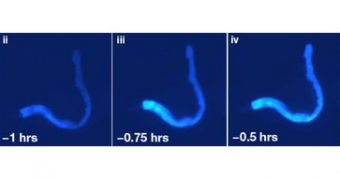Scientists at the University College London have recently taken the time to investigate what happens when worms die of old age.
They've found that death moves through their bodies much like a wave, and that the biological processes it triggers result in the emergence of a fluorescent blue light.
“We've identified a chemical pathway of self-destruction that propagates cell death in worms, which we see as this glowing blue fluorescence traveling through the body.”
“It's like a blue grim reaper, tracking death as it spreads throughout the organism until all life is extinguished,” study leader David Gems explains, as cited by Medical Daily.
The researchers explain that, although the scientific community has pretty much figured out what happens when individual cells die, the mechanisms involved in causing systemic collapse in a living organism have thus far remained largely undocumented.
To investigate this issue, the scientists closely monitored several nematodes, otherwise known as roundworms.
As shown is the picture next to this article, the imminence of death prompted a cascade of cell necrosis.
A molecule found in the cells that were dying started emitting a fluorescent blue light that eventually engulfed the entire body.
What is interesting is that this molecule is similar to a compound found in the bodies of mammals that have died of old age, the researchers reportedly detail in their paper in the journal PLOS Biology.
“Organismal death is accompanied by a burst of intense blue fluorescence, generated within intestinal cells by the necrotic cell death pathway,” the researchers write.
“This [i.e. the blue fluorescent substance] has similar spectral properties to lipofuscin, a product of oxidative damage known to accumulate with age in postmitotic mammalian cells,” they further explain.
The specialists expect that their findings will shed new light on how human death occurs, especially in the case of old people.
In time, a better understanding of this process could make it possible for scientists to pin down means of prolonging human life.

 14 DAY TRIAL //
14 DAY TRIAL //